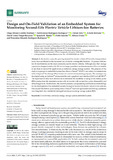Mostrar el registro sencillo del ítem
Design and on-field validation of an embedded system for monitoring second-life electric vehicle lithium-ion batteries
| dc.creator | Castillo Martínez, Diego Hilario | es_ES |
| dc.creator | Rodríguez Rodríguez, Adolfo Josué | es_ES |
| dc.creator | Soto Cabria, Adrián | es_ES |
| dc.creator | Berrueta Irigoyen, Alberto | es_ES |
| dc.creator | Vargas Requena, Dávid Tomás | es_ES |
| dc.creator | Matías Maestro, Ignacio | es_ES |
| dc.creator | Sanchis Gúrpide, Pablo | es_ES |
| dc.creator | Ursúa Rubio, Alfredo | es_ES |
| dc.creator | Rodríguez Rodríguez, Wenceslao Eduardo | es_ES |
| dc.date.accessioned | 2022-09-16T06:09:30Z | |
| dc.date.available | 2022-09-16T06:09:30Z | |
| dc.date.issued | 2022 | |
| dc.identifier.citation | Castillo-Martínez, D.; Rodríguez-Rodríguez, A.; Soto, A.; Berrueta, A.; Vargas-Requena, D.; Matias, I.; Sanchis, P.; Ursúa, A.; Rodríguez-Rodríguez, W.. (2022). Design and on-field validation of an embedded system for monitoring second-life electric vehicle lithium-ion batteries. Sensors. Vol. 22,(17) pp. 6376-6376 . | en |
| dc.identifier.issn | 1424-8220 | |
| dc.identifier.uri | https://hdl.handle.net/2454/44023 | |
| dc.description.abstract | In the last few years, the growing demand for electric vehicles (EVs) in the transportation sector has contributed to the increased use of electric rechargeable batteries. At present, lithium-ion (Li-ion) batteries are the most commonly used in electric vehicles. Although once their storage capacity has dropped to below 80¿70% it is no longer possible to use these batteries in EVs, it is feasible to use them in second-life applications as stationary energy storage systems. The purpose of this study is to present an embedded system that allows a Nissan® LEAF Li-ion battery to communicate with an Ingecon® Sun Storage 1Play inverter, for control and monitoring purposes. The prototype was developed using an Arduino® microcontroller and a graphical user interface (GUI) on LabVIEW®. The experimental tests have allowed us to determine the feasibility of using Li-ion battery packs (BPs) coming from the automotive sector with an inverter with no need for a prior disassembly and rebuilding process. Furthermore, this research presents a programming and hardware methodology for the development of the embedded systems focused on second-life electric vehicle Li-ion batteries. One second-life battery pack coming from a Nissan® Leaf and aged under real driving conditions was integrated into a residential microgrid serving as an energy storage system (ESS). | en |
| dc.description.sponsorship | This work was supported by: 1. Spanish State Research Agency: PID2019-111262RBI00/AEI/10.13039/501100011033; 2. Government of Navarra under Research Project: 0011-1411-2022-000039 HYBPLANT; 3. European Union's Horizon 2020 Research and Innovation Programme (Stardust-Holistic and Integrated Urban Model for Smart Cities) under Grant 774094.; 4. To the Autonomous University of Tamaulipas (México) for APC support. | en |
| dc.format.mimetype | application/pdf | en |
| dc.language.iso | eng | en |
| dc.publisher | MDPI | en |
| dc.relation.ispartof | Sensors, 2022, vol. 22 (17), pp. 6376-6376 | en |
| dc.rights | © 2022 by the authors. This article is an open access article distributed under the terms and conditions of the Creative Commons Attribution (CC BY) license | en |
| dc.rights.uri | https://creativecommons.org/licenses/by/4.0/ | |
| dc.subject | Li-ion battery | en |
| dc.subject | Stationary energy | en |
| dc.subject | Storage system | en |
| dc.subject | Embedded system | en |
| dc.title | Design and on-field validation of an embedded system for monitoring second-life electric vehicle lithium-ion batteries | en |
| dc.type | Artículo / Artikulua | es |
| dc.type | info:eu-repo/semantics/article | en |
| dc.date.updated | 2022-09-16T06:06:18Z | |
| dc.contributor.department | Ingeniaritza Elektrikoa, Elektronikoaren eta Telekomunikazio Ingeniaritzaren | eu |
| dc.contributor.department | Institute of Smart Cities - ISC | en |
| dc.contributor.department | Ingeniería Eléctrica, Electrónica y de Comunicación | es_ES |
| dc.rights.accessRights | Acceso abierto / Sarbide irekia | es |
| dc.rights.accessRights | info:eu-repo/semantics/openAccess | en |
| dc.identifier.doi | 10.3390/s22176376 | |
| dc.relation.projectID | info:eu-repo/grantAgreement/AEI/Plan Estatal de Investigación Científica y Técnica y de Innovación 2017-2020/PID2019-111262RB-I00/ES/ | en |
| dc.relation.projectID | info:eu-repo/grantAgreement/European Commission/Horizon 2020 Framework Programme/774094 | en |
| dc.relation.publisherversion | https://doi.org/10.3390/s22176376 | |
| dc.type.version | Versión publicada / Argitaratu den bertsioa | es |
| dc.type.version | info:eu-repo/semantics/publishedVersion | en |
| dc.contributor.funder | Gobierno de Navarra / Nafarroako Gobernua | es |



